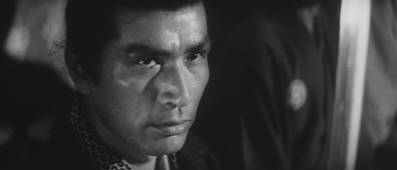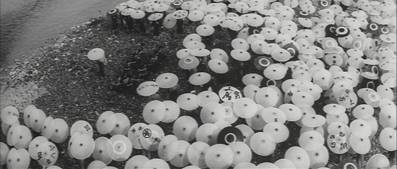|
Masahiro
Shinoda's 1964 film Assassination [Ansatsu] kicks off with two minutes of voiced textual scene setting.
I'd read it if I were you, and carefully. You might even
want to make notes, as this not only sets up the historical
context for the film, it outlines events that have bearing
on and are intermittently referred to throughout the narrative.
It
would probably be fair to say that Assassination
was made primarily with a Japanese audience in mind, one
with a sound knowledge of their own history and able to
fill in the gaps that the film sometimes trots over. The
plotting here is complex and the narrative non-linear, so
dropping your concentration, even for a few seconds, could
well leave you scratching your head and wondering just who
this person is, why these events are taking place, and even
when they are occurring. It took me two viewings to get things really
clear, and assistance from a Japanese friend to appreciate
the historical elements and help separate truth from creative
storytelling.

The
arrival of The Black Ships in July 1853 was a crucial moment
in Japanese history. Commanded by Commodore Matthew Perry,
the five American warships arrived at Uraga Port in Edo
(now Tokyo) bearing a letter for the Emperor from US President
Fillmore requesting the opening of trade links with Japan,
effectively ending 300 years of national seclusion. The
issue divided the country – the Shogunate, who were fearful
of the Americans' superior firepower, were in favour of
a treaty, while the Emperor and his followers fiercely opposed
what they saw as a threat to The Divine Land.
The
film starts off ten years after this event, when the opposing factions
are still in often violent opposition. A skilled ronin
named Hachiro Kiyokawa, who has been convicted of killing
a policeman, is offered amnesty if he will gather together
unemployed samurai to protect the Shogun and defeat those
still loyal to the Emperor, to whom he was once loyal. He nevertheless accepts the undertaking, a move
that bemuses his previously loyal followers, some of whom
start plotting against him as a result. Although his new employers do
not trust him, they are aware that he is the perfect man
to organise their Free Samurai Army – or Shinsengumi – but
as a reserve plan they engage Tadasaburo Sasaki, a skilled instructor
at the nearby samurai school, as a potential assassin should the need arise.
Given
that the story revolves around Kiyokawa, on my first viewing
of the film I was a little surprised that it took so long
for us to connect with him as a character – in the
early scenes he is frequently observed either in wide shot
or with his face masked by a large straw hat, with full-face
close-ups reserved largely for later. But on
the second viewing it was clear that this is entirely
the point. This is less a story of Kiyokawa
the person than a gradual demystification of a man who has taken on almost
mythical status. It also has a specific narrative
purpose. Sasaki, charged the task of possibly having to
kill a swordsman whose skill is superior to his own, determines
to learn as much about Kiyokawa as he can, and our process
of discovery runs alongside his. Mind you, Sasaki's investigations
are driven only in part by his sense of duty – on their
first meeting, Kiyokawa humiliates him in front of his own
students by easily besting him in a fencing match, harming both
his pride and his reputation, both of which he becomes increasingly
desperate to restore. In addition, his understanding of
the man is only partial, as key information is revealed
not to him but to one of Kiyokawa's most loyal students,
who is conducting his own enquiry in an attempt to understand the
sudden side-switch of a man who once saved his life.

It
is with the onset of Sasaki's investigations that the film
begins time-flipping and sometimes unexpected details of
Kiyokawa's past are revealed. Though we are led clearly
into these sequences by a memory or a diary entry, the film
can hop out of them almost invisibly and not always return to the
pre-flashback location. It is in these scenes that the events
outlined in the opening are most frequently referred to,
including the story's first assassination, that of Premier
Ii, which those loyal to the Emperor see as the first major
step on their road to victory over the Shogonate supporters.
A lot of what takes place
here is based on historical fact. The arrival of the Black
Ships and the internal disputes that followed were events
that changed Japan forever, and the assassination of Premier
Ii was an actual occurrence that took place in March of
1860, something that shook the Shogunate and led to the
politically motivated marriage between Shogun Iemochi and
the Emperor's sister, Princess Kazu. Perhaps more surprising
to those new to these events is that Hachiro Kiyokawa was
also a genuine historical figure and the plan to recruit
large numbers of ronin for a Free Samurai Army is credited
to him, and he did indeed lead them to Kyoto as a bodyguard
force for Shogun Iemochi.* Specific incidents are even linked
historically significant events, such as the attack on the
Satsuma clan members at the Teradaya Inn (an event my friend
assures me took place but which I have been unable to independently
verify as yet), a venue that the following morning is visited
by Kiyokawa's friend Sakamoto, who observes the destruction
left by the fight and then sits down to mournfully sing.
This could almost be seen as a moment of premonition, as in 1866
rebel samurai Sakamoto Ryoma was ambushed at this very inn,
which was his favourite such establishment and home to his girlfriend Oryo
(he survived but was assassinated the following year). This
reference would definitely not be lost on a domestic audience,
for whom Ryoma remains a well known and respected figure – the Teradaya Inn still stands today and includes a memorial
to him. There is also a Sakamoto Ryomo memorial museum in Urado
Castle Park in Katurahama, and in 2003 the Kochi Airport
was renamed the Kochi Ryoma Airport in his honour.
Whether
the Kiyokawa of the film is ever really a likeable figure
is of little real consequence. There are no clear-cut heroes
and villains here and just about everybody appears capable
of acting without honour or concern for the fate of feelings
of others. Thus Kiyokawa's status as warrior of almost superhuman
fighting skills is tainted when he unexpectedly beheads
a policeman without provocation and is chased halfway across
town by an angry mob. Then again, the officials searching
for his whereabouts waste no time in beating and torturing
his girlfriend Oren, the one genuinely innocent player in
the piece and the only person Kiyokawa appears to connect
with on a meaningful level.

If
Assassination does not engage the emotions,
it certainly rewards the intellect and on the way provides
moments of genuine visual splendour, from Kiyokawa's night-time
fight with a group of ex-followers who feel betrayed by
his apparent switch of allegiance, to the eye-catching wide
shots (the scope frame is very well used here) of the Free
Samurai Army en route to Kyoto, and a gobsmaking high angle shot of the army sheltering under a sea of white
umbrellas. The process of uncovering the truth (well, the
film's version of it) about Kiyikawa is an engrossing and
sometimes surprising one and provides for an intriguingly
structured narrative and an involving finale. Just remember,
this is not one to run when you're getting a bit tired or
when you're dividing your time between the film and a noodle
dinner – bring your whole concentration to Assassination
and it will be rewarded.
Masters
of Cinema appear to have had problems with all of their
Shochiku sourced prints, and Assassination is no exception. Framed 2.35:1 and anamorphically enhanced,
the quality is somewhat variable – at best the contrast
and sharpness are rather good, but elsewhere black levels
have been strengthened at the expense of picture detail,
resulting in sequences that look muddy and shots where shadow
detail is non-existent. Brightness also varies,
sometimes from shot to shot, greying out the contrast in
places and darkening the picture noticeably in others. On
the plus side the print is virtually spotless, but this
is not one of Masters of Cinema's best transfers.
The
Dolby 1.0 mono track has a very slight hiss, expected for
a film of this period, plus the odd small pop, but is otherwise
more than serviceable.
The
subtitles are clear and a reasonable translation, but unusually
I spotted three typos, making me wonder if the subtitling
was done by Eureka or part of the package from Shochiku.
No
commentary on this one, but there is an Introduction
(9:36) by Alex Cox, whose enthusiasm for the film is certainly
infectious, and if the first viewing leaves you a little
baffled then this is as good a place to start for help with
the second.
There
is also a Gallery of 27 production stills
that are in good shape and reproduced at a decent size.
The
expected Booklet is also promised,
but was not supplied with the review disk. Hopefully it
will give some social and historical background to the film
to help out the newcomers.
A
tricky one this. Assassination is an intricately
structured film that rewards the attentive and the patient,
but could prove hard to follow for those with their eyes
not glued to the subtitles or familiar with the background
to the story. The presentation is a bit below par, which
doesn't help, and the disk is not exactly flush with features.
But for its direction, the lead performances (including
old hand Tetsuro Tamba and Isao Kimura, who played the young
novice in Kurosawa's Seven Samurai), and
the narrative structure, it is definitely one that fans of
Japanese historical cinema should check out. But to paraphrase
a well known office poster, you don't need to know your
Japanese Samurai history to enjoy the film, but it certainly
helps.
*
Hachiro Kiyokawa even turns up as a character in the Japanese
Playstation 2 game Kengo 3, in which he
is required to form the Shinsengumi, the very event portrayed
in this film.
|